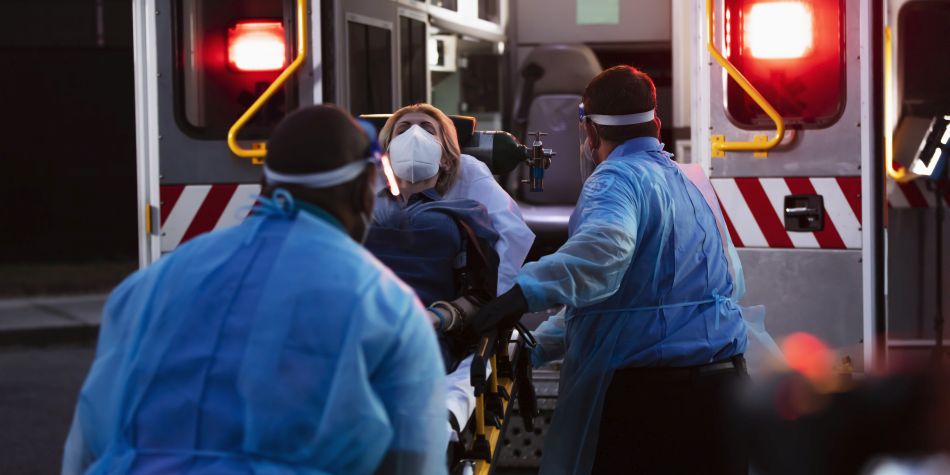
In a medical emergency, teams of people within the community come together to care for patients. Often, the first responders to the medical emergency provide care in the patient’s environment, be it his home or the site of an accident. These first responders provide immediate medical care and transport patients to the hospital for additional support. Although it may appear that first responders and their hospital counterparts are working as two separate groups, in reality, they work in tandem to provide life-saving care to patients.
“Collaboration between our hospital emergency departments and first responders is critical to ensure the transition of care from EMS to hospital is seamless and results in the best possible outcome for patients,” explains Dr. Jake O’Shea, chief medical officer with HCA Healthcare Capital Division.
Emergency medical services (EMS)
Emergency medical services (EMS) systems are complex and designed to work together to provide emergent care to patients in immediate need of assistance. The systems are shaped by the communities in which they are found; in general, they are comprised of dispatchers, first responders, fire departments, ambulance agencies, and hospital emergency departments/trauma centers.
When a call for assistance is placed, the dispatcher connects EMS providers to the emergent situation. The responding EMS team may include Emergency Medical Technicians (EMTs) or paramedics. The dispatcher not only informs the emergency personnel where to go, they also update that team on the type of care that will most likely be needed upon arrival.
EMS to hospital care
According to the National Association of Emergency Medical Technicians, once on scene, EMS providers deliver “prehospital and out-of-hospital emergent, urgent or preventive medical care that may include assessment [and] treatment.” Many patients treated by EMS providers, such as those who suffer from strokes, heart attacks, or are significantly injured require additional care in a hospital emergency department (also known as an ER). EMS providers work to quickly and efficiently support and transport those patients to a local care facility by ambulance; some of the most severely sick or injured patients may be transported by air medical service.
Air medical services
Transportation by ambulance is typical for most emergent situations. The ambulance is supplied with medical supplies to initiate care for patients, and empowers the EMS team to provide care not only on site, but also while traveling quickly to a local care facility. In some circumstances, ground transport options are not available, or a patient needs a faster, more advanced level of care during transport to a facility. In these situations, an air medical service may be used.
Air medical services are typically helicopters that are staffed by certified critical care nurses and paramedics. These helicopters are equipped to provide advanced patient management, such as critical care monitoring, mechanical ventilation, advanced medications, blood products, and invasive procedures like intubation. With this level of care, air medical services can care for high-risk patients while the helicopter transports them to a hospital emergency department as rapidly and safely as possible.
“We know that outcomes are better for patients with many medical conditions, such as strokes, sepsis, and heart attacks, when the correct treatment is delivered more rapidly,” says Dr. O’Shea. “When EMS providers are able to deliver stabilizing care and rapidly and safely transport patients to the hospital, it gives people the best chance at a positive outcome.”
Emergency rooms and trauma centers
Emergency departments (EDs) may be found either within a hospital or as a free-standing emergency department (FSED). Both hospital-based EDs and FSEDs provide care to patients with a broad range of medical life-threatening and non-life-threatening medical conditions. Some hospitals receive additional designation as trauma centers, which means they are have special equipment and personnel to handle serious injuries caused by car crashes, gunshot wounds, traumatic brain injuries, stab wounds, serious falls, and other forms of blunt trauma.
Regardless of how a patient arrives at an emergency department or trauma center, EMS providers are trained to quickly and efficiently engage with hospital care providers, both in route and upon arrival, to share relevant patient medical information. “Communication from EMS teams while they are en-route can help ensure our hospital colleagues are ready to provide life-saving care from the moment the patient arrives,” concludes Dr. O’Shea.
Source
National Association of Emergency Medical Technicians. (2017, April 17). What is EMS? National
Association of Emergency Medical Technicians. Retrieved June 14, 2022, from http://www.naemt.org/docs/default-source/about-ems/what-is-ems-for-web-04-17-2017.pdf?status=Temp&sfvrsn=0.46038588091233634